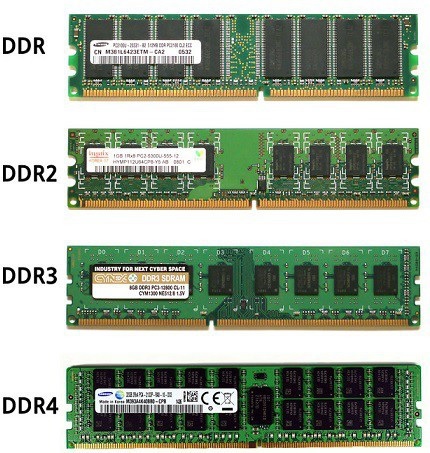RAM system's short-term memory. Whenever computer performs calculations, it temporarily stores the data in the RAM until it is needed. This short-term memory disappears when the computer is turned off. If you're working on a document, spreadsheet, or other types of file, you'll need to save it to avoid losing it. When you save a file, the data is written to the hard drive, which acts as long-term storage. RAM is measured in megabytes (MB) or gigabytes (GB). The more RAM you have, the more things your computer can do at the same time. If you don't have enough RAM, you may notice that your computer is sluggish when you have several programs open. Because of this, many people add extra RAM to their computers to improve performance. RAM is much faster than ROM is, due to the nature of how it stores information. For this reason, RAM is often used to shadow the BIOS ROM to improve performance when executing BIOS code. PROM (Programmable ROM) is also a version of ROM and is slower compared to RAM. EEPROM, Electrically Erasable Programmable ROM is used to program dynamically.EPROM, Erasable Programmable ROM can be erased with ultra violet light.
There are basically two important types of RAM (Short for Random Access Memory):
1. SRAM: Static RAM being expensive, primarily used for Cache memory. DRAM, being cheaper, is used for main memory. SRAM is widely used for Level 1, Level 2 or Level 3 cache memory. Level 1 cache is internal to the processor, and level 2 and level 3 caches are external to the processor, it resides on the motherboard.
2. DRAM: Dynamic RAM holds its data if it is continuously accessed by special logic called a refresh circuit. If the memory is not refreshed regularly, then the DRAM will lose its contents. This refreshing action is why the memory is called dynamic. All PCs use DRAM for their main system memory, instead of SRAM, even though DRAMs are slower than SRAMs and require the overhead of the refresh circuitry. The reason that DRAMs are used is that they are much cheaper and take up much less space.
The computer main memory usually consists of some type of DRAM. Types of DRAM Packages and DRAM Memory are explained below:

PC ratings and corresponding DDR bandwidth are given below:
DDR266 = PC2100
DDR333 = PC2700
DDR400 = PC3200
DDR2-400 = PC2-3200
DDR2-533 = PC2-4200
DDR2-667 = PC2-5300
DDR2-800 = PC2-6400
DDR3-800 = PC3-6400
DDR3-1066 = PC3-8500
DDR3-1333 = PC3-10600 DDR3-1600 = PC3-12800
DR400 memory is also referred to as PC3200 memory. 400MHz
DDR2 memory would be listed as PC2-3200, and so on.
SDRAM DIMM (Dual In-line Memory Modules): SDRAM stands for Synchronous Dynamic Random Access Memory. DIMMs allow the ability to have two rows of DRAM chips. They are able to contain twice as much memory on the same size circuit board compared to SIMM (stands for Single Inline Memory Module, and not used now-a-days). In its basic form, DIMMs contain 168 pins and transfer data in 64 bit chunks. SDRAM DIMMs with 168 pins have two notches on the bottom of the PCB.
DDR DIMM: DDR DIMMs have 184 pins and may be identified by one notch at the bottom of the module. Note that DDR2 and DDR3 modules also have only one notch at the bottom of the board. However, they may be identified by the position of the notch. As may be observer, DDR (DDR1) modules have a notch to slightly to the right in comparison with DDR2 memory module, and DDR3 has a notch to far left of the bottom of the module as may be seen in the figure above.
DDR3 DIMM Memory module: DDR3 memory modules are available in both DIMM and SO-DIMM form factors. DIMMs are commonly used for desktop PCs, while SO-DIMMs are typically used for laptops and all-in-one computers. While DDR3 DIMMs and SO-DIMM are the same size as their DDR2 counterparts, they are not compatible with DDR2 RAM slots. The connecting pins are arranged differently, so it is physically not possible to insert a DDR3 memory module into a DDR2 or DDR slot, and vice versa.

SO DIMM (Small Outline DIMM): SO DIMMs are commonly used in notebooks and are about half the size of normal DIMMs. 144-pin SO-DIMMs have a single notch near the center , 200-pin SO-DIMMs have a single notch nearer to one side. The exact location of this notch varies. 204-pin SO-DIMMs (DDR3) have a single notch closer to the center than on 200-pin SO-DIMMs. The 200-pin SO-DIMM may belong to types DDR or DDR2. The notch location is different in both the cases, and these two types of memory are not interchangeable.


